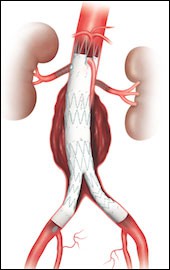Minimally Invasive Repair of the Aorta - Zenith Fenestrated AAA Endovascular Grafts
The vascular surgeons at Northwestern’s Bluhm Cardiovascular Institute were the first in Chicago to begin treating patients with aortic aneurysms with endovascular repair. This minimally invasive procedure can allow for a shorter hospital stay and faster recovery when compared to traditional open surgery. Endovascular repair has become the most common treatment for aortic aneurysms and is performed on more than 70 percent of patients with aortic aneurysms in the United States.
Zenith Fenestrated AAA Endovascular Grafts
 The Zenith Fenestrated AAA Endovascular Graft is a unique type of endovascular graft developed for patients with abdominal aortic aneurysms (AAA) that were previously not considered candidates for endovascular repair. In particular, the Zenith Fenestrated Graft allows endovascular treatment of aneurysms that are near the arteries providing blood flow to the kidneys while maintaining blood flow to the kidneys after the repair is complete.
The Zenith Fenestrated AAA Endovascular Graft is a unique type of endovascular graft developed for patients with abdominal aortic aneurysms (AAA) that were previously not considered candidates for endovascular repair. In particular, the Zenith Fenestrated Graft allows endovascular treatment of aneurysms that are near the arteries providing blood flow to the kidneys while maintaining blood flow to the kidneys after the repair is complete.
The graft is custom manufactured to a patient’s specific anatomy based on the size and position of the aorta and its branch arteries to the kidneys and intestine. The custom measurements for each graft are made based on a high-resolution CT scan performed before surgery.
The distal body connects to the proximal body, providing continued blood flow into the iliac arteries, which provide blood flow to the pelvis and legs. The iliac limb grafts connect to the distal body, providing a seal in the iliac arteries. The renal artery stent-grafts help to seal the top of the aneurysm repair while maintaining blood flow to the kidneys.
How endovascular grafts are placed in the body
 Your physician will measure your aorta and its branch arteries using a high-resolution CT angiogram (a test to visualize the arteries and veins of the body) to design a custom graft that is appropriate for your anatomy. No two patients are the same, and careful measurement at this stage is critical for good results.
Your physician will measure your aorta and its branch arteries using a high-resolution CT angiogram (a test to visualize the arteries and veins of the body) to design a custom graft that is appropriate for your anatomy. No two patients are the same, and careful measurement at this stage is critical for good results.
To place the graft in the body, your physician will make a small incision near each hip, near the crease between your abdomen and thigh, to access the femoral arteries, which provide blood flow to the legs and feet. Each part of the graft is inserted separately into your bloodstream through these incisions, and each part of the graph comes in its own plastic sheath. Once in the body, the sheath is removed, allowing the graft to open and create a new lining within the aorta to seal off the aneurysm.
Your physician will use X-rays to confirm that the blood is flowing to the branch vessels and iliac arteries, and to make sure that blood is not flowing into the aneurysm. Then your physician will close up the incisions used to place the graft.
Benefits of endovascular treatment
Endovascular aneurysm repair is designed to eliminate the chance of future aneurysm rupture. Additional benefits include:
- Faster return to normal daily activities
- Improved clinical outcomes
- Less blood loss
- Less pain
- Shorter recovery time
- Smaller incisions with less scarring
Possible complications
Some possible complications of the Zenith Fenestrated AAA Endovascular Graft may include:
- Blood transfusion (16–20 percent possibility)
- Decreased or absent blood flow to the renal artery (11–15 percent possibility)
- Abnormal or irregular heartbeat (5–10 percent possibility)
Follow-up for endovascular treatment
If you receive a Zenith Fenestrated AAA Endovascular Graft, you will need regularly scheduled follow-up to monitor your repair. Follow-up appointments may include a CT scan or abdominal ultrasound to ensure that the repair remains in good position and that there is good blood flow through all graft components.
Talk with your physician if you have any concerns during these regular checkups. They should be considered part of a lifelong commitment to your health, and are necessary to allow your physician to evaluate your treatment and any changes you may experience over time.
If you experience one of the following symptoms, you should contact your physician immediately:
- Pain in legs, abdomen or chest
- Numbness in legs, abdomen or chest
- Weakness in legs, abdomen or chest
- Dizziness
- Fainting
- Rapid heartbeat
- Leg discoloration or coolness
- Decreased urination
Clinical trials
Ongoing clinical research trials at the Center for Vascular Disease are investigating new treatments options for abdominal aortic aneurysms to ensure that our patients continue to receive the most innovative care in the country. Learn more about research and clinical trails.
Meet the Thoracic Aortic Disease Team
| Northwestern Medicine Bluhm Cardiovascular Institute is a nationally recognized destination for those who require highly specialized cardiovascular care. | Meet the Team Downtown Chicago |
